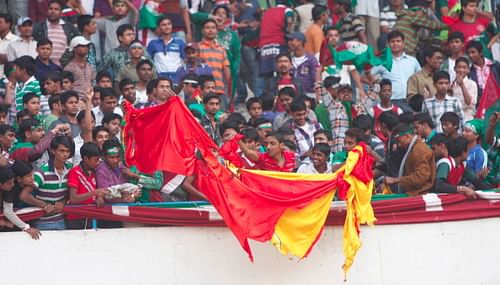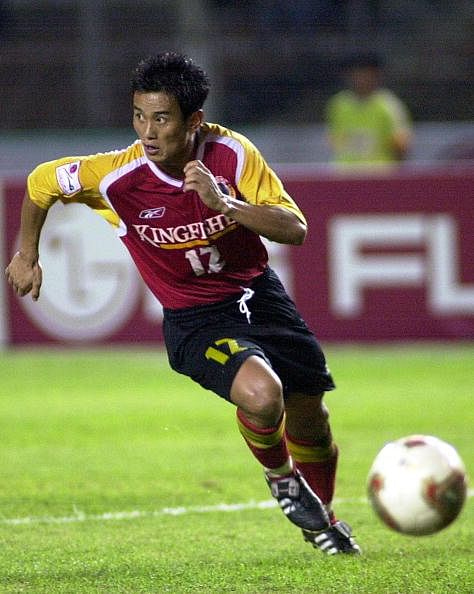
Down the memory lane - 'The Diamond demolition' in Kolkata derby

Kolkata derby is the most awaited match in a football fanatic’s calendar in the city.
The year was 1997, and on the 13th of July, the stage was set for the biggest clash in Indian football – the Kolkata derby. Mohun Bagan and East Bengal were to battle it out at the Salt Lake Stadium which is the second biggest non-motorsport stadium in the world.
The Kolkata Derby
Mohun Bagan AC was set up in 1889 and the club achieved fame in 1911 when it became the first Indian team to defeat a European side, beating Eastern Yorkshire Regiment 2-1 barefoot in the final of the Indian Football Association Shield. Like in many footballing rivalries around the world, this was also a case of where one club was born after secession from an establishment.
In 1920, Mohun Bagan was due to play Jorabagan in a Coochbehar Cup tie. When star defender Sailesh Bose wasn’t picked by Jorabagan, the Mohun Bagan Vice President Suresh Chandra Chaudari asked the club authorities to include him in Mohun Bagan’s squad. Mohun Bagan refused to do the same, and Chaudari walked out of the club and along with Sailesh Bose formed a new club called East Bengal, named after the region they were from. East Bengal was traditionally supported by migrants from East Bengal (now Bangladesh) and Mohun Bagan by the so-called ‘locals’. So, as it is like in footballing rivalries all over the world, the hatred amongst the fans stemmed from the different socio-economic backgrounds they were from.
The Diamond Demolition
The East Bengal team before the famous “Diamond Demolition” match in 1997
The most famous Kolkata derby in recent times was the 1997 Federation cup semifinal. 130,000 (Yes, 130,000. Now think twice the next time you claim the Manchester Derby or El Clasico is the biggest game in the world) fans packed the Salt Lake Stadium in Kolkata to witness the clash between the two footballing powerhouses in India. The Salt Lake Stadium (Yuva Bharti Krirangan or the Stadium of Indian Youth) acts as the home ground for both the clubs. The atmosphere before the game was at feverish pitch mainly due to the respective coaches.
Amol Dutta, Mohun Bagan’s coach was enjoying a period of success as his ‘Diamond’ the 3-2-3-2 formation enabled Mohun Bagan to destroy Churchill Brothers 6-0 in the previous game. Mohun Bagan were hyped as the favourites and many didn’t give East Bengal much chance against Dutta’s Diamond.
P.K. Banerjee, East Bengal’s coach was possibly the most famous man in Indian football at that time. He was the captain of the Indian national team when they held France to a famous 1-1 draw and it was he who scored the equaliser at the 1960 Rome Olympics. But after the game, the name on everyone’s lips was neither Dutta nor Banerjee.
The match was hyped by the media all over the country. Football mattered little to people in the other parts of a cricket-crazed country and generally wasn’t even shown on Television. But the Government broadcaster Doordarshan decided to telecast it live, albeit coming upon the decision at a very late stage. The frenzied East Bengal and Mohun Bagan supporters couldn’t miss the opportunity to witness the match, and hence it resulted in a record attendance of 131,000 which was clearly above the capacity of the three-tier stadium.
 Another sub-plot to this game was the return of Bhaichung Bhutia to East Bengal. Bhaichung, who started out at East Bengal at the age of 16, was transferred to JCT Mills the previous year. JCT mills won the 1996-97 season of the Indian National Football League and Bhutia was was the top scorer. In 1997 he came back to East Bengal and the rest, as they say, is history. Bagan’s coach Dutta further added fuel to fire when he made comments about Bhaichung, reportedly terming him as ‘Chung-Chung’ and stating that he played like petroleum on fire (Not quite sure what he really meant by that).
Another sub-plot to this game was the return of Bhaichung Bhutia to East Bengal. Bhaichung, who started out at East Bengal at the age of 16, was transferred to JCT Mills the previous year. JCT mills won the 1996-97 season of the Indian National Football League and Bhutia was was the top scorer. In 1997 he came back to East Bengal and the rest, as they say, is history. Bagan’s coach Dutta further added fuel to fire when he made comments about Bhaichung, reportedly terming him as ‘Chung-Chung’ and stating that he played like petroleum on fire (Not quite sure what he really meant by that).
Mohun Bagan, who were the favourites started out as usual in their 3-2-3-2 formation, but it was East Bengal with their star striker who had the last laugh. In the 36th minute, East Bengal took the lead and kept it till the half time. The second half was all about Bhutia, as he scored a wonderful hat-trick to demolish the ‘Diamond’ and silence Amol Dutta. East Bengal fans cherish this match till date as they witnessed the coming of age of India’s greatest footballer of modern era, Bhaichung Bhutia. Till date, Bhaichung is the only footballer to score a hat-trick in the historic Kolkata Derby. East Bengal fans claim that this is the highest ever attendance for a match between two football clubs in the world. I’m not sure about that, but it is even more impressive considering that it was held on a weekday.
Match Video
Bhaichung’s Interview
Bhaichung subsequently played for Mohun Bagan after his stint with English side FC Bury.
The Boro (Big in Bengali) match, as it is known locally takes place a minimum of 4 times every year, as the sides face twice in the local Calcutta league and twice in the national league. Also, there are additional encounters if they manage to meet in the Cup Competitions like IFA Shield, Federation Cup, etc. Local police have to be at their best during these derbies as violence is a part and parcel of these clashes.
The English Premier League and the Champions League has now captured the imagination of Indian football fans and games like Manchester United vs Liverpool are more eagerly awaited now. But for the hardcore football fanatic on the streets of Kolkata, the only date marked in his calendar will be of the local derby.